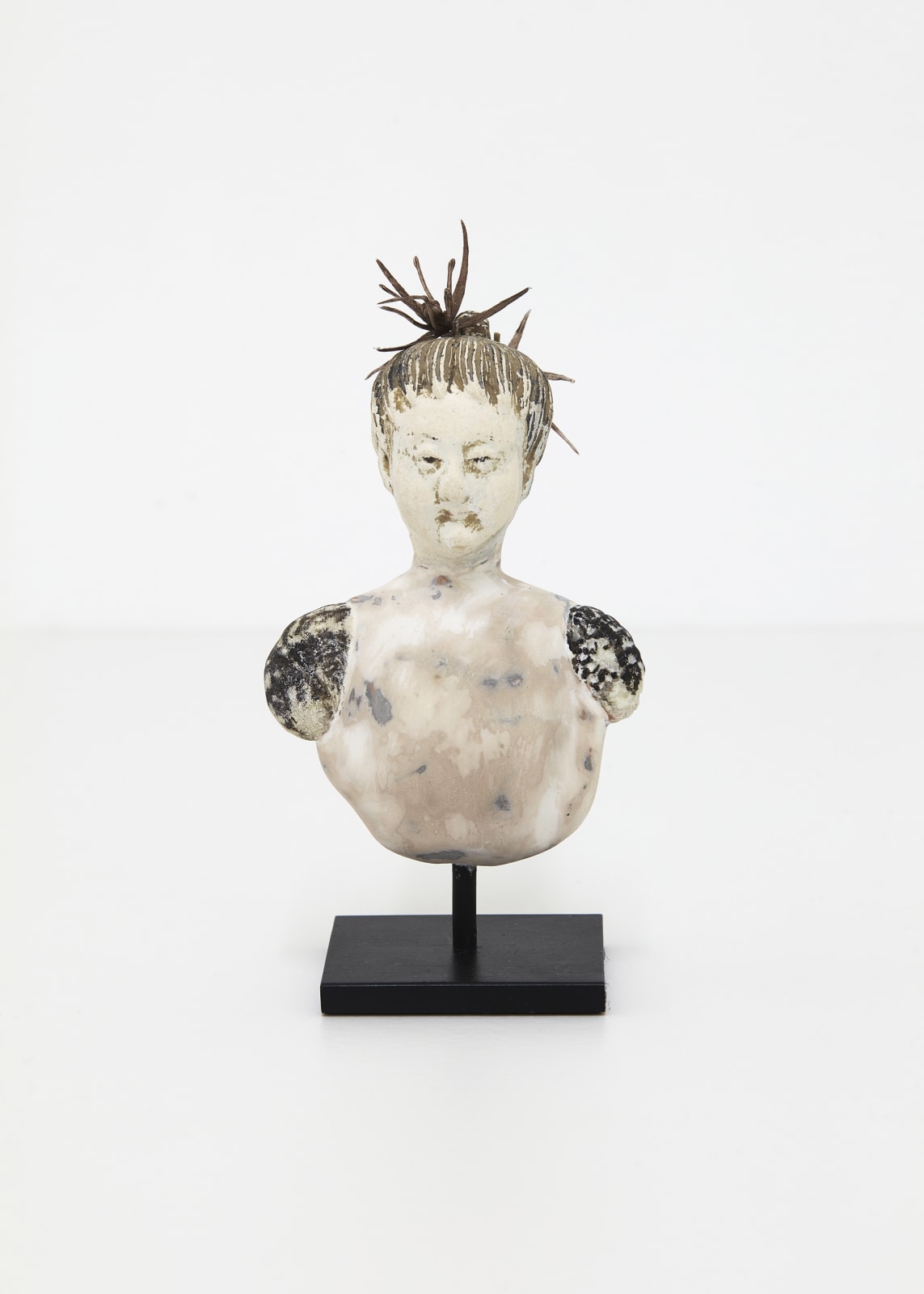Leelee Chan 陳麗同
Performer #5 表演者五, 2021
Ming dynasty (1368-1644) Chinese pottery fragment, found seashells, faux plant, epoxy, brass, aqua resin, pigment 明代(1368-1644年)陶俑碎片,拾得貝殼,仿真植物,環氧樹脂,黃銅,水性樹脂,顏料
15.5 x 5.5 x 5.5 cm
6 x 2 x 2 in
6 x 2 x 2 in
更多图片
In combining the ancient with the contemporary, Chan’s idiosyncratic assemblies initiate a new dialogue between history and the present. Tomb owners commissioned the pottery figures to materialize their ideal vision...
In combining the ancient with the contemporary, Chan’s idiosyncratic assemblies initiate a new dialogue between history and the present. Tomb owners commissioned the pottery figures to materialize their ideal vision of the afterlife. Though not meant to be seen by the living, these funerary objects provide glimpses into the everyday life of the past. The eleven sculptures combine fragments of the pottery with Chan’s collection of “antiquities of nature”, including seashells, minerals, stones, and mundane objects and industrial materials from her everyday life.
As in much of her work, Chan poses questions on the idea of value and explores the evolving meanings of these objects. Drawing inspiration from her antique background and experience of pottery figure restoration, Chan collected from different antique dealers and restorators fragments of pottery figures no longer considered “useful” and “useable”. Unearthed and broken, these tomb figures lost their original role and purpose.
Chan thus explores the connection between the archaeology of the past and her archaeology of the present. The recurring themes of “竹ands” and stage-like compositions in her sculptures reconfigure and reinvigorate the lost identities of the pottery figures, turning them into protagonists in new imaginative narratives drawn from her personal experience and contemporary culture (literature, music, theatre, etc.). At the same time, these art works convey Chan’s curiosity about the “hands”, which symbolize the original makers of the figures and the marks they left behind, and also the gestures of “making” in her practice.
陳麗同的作品別具一格,將古物與現代物件相結合,引發歷史和現代的新一輪對話。墓穴主人定做陶俑以塑造理想的身後世界。這些物件本不應為世人所見,如今卻讓我們一窺遠古社會的日常生活。十一件雕塑均聚合了陶俑碎片和雕塑家的「自然古物」藏品,包括貝殼、礦石、石頭,以及日常生活中常見的物件和工業用具。
藝術家透過這批作品再次質疑價值的理念,並探討物件不斷演化的意義。其靈感來自個人的古董研究背景和陶俑修復經驗,用料則是從多個古董商和修復者收集失去「有用」或「可用」價值的陶俑碎片。這些出土的殘片已失去本來的角色和價值。
由此,陳麗同探索考古和現代考古的連繫。她的作品常道出「手」和舞台裝置般的主題。藝術家運用個人經驗和現代文化(文學、音樂、劇場等)創作新的論述,將這些本已失去意義的陶俑轉化為故事主角,為它們重新定位並注入生命。與此同時,藝術品透露了她對「手」的好奇:「手」既代表陶俑匠人及其留下的痕跡,亦是她創作的象徵。
As in much of her work, Chan poses questions on the idea of value and explores the evolving meanings of these objects. Drawing inspiration from her antique background and experience of pottery figure restoration, Chan collected from different antique dealers and restorators fragments of pottery figures no longer considered “useful” and “useable”. Unearthed and broken, these tomb figures lost their original role and purpose.
Chan thus explores the connection between the archaeology of the past and her archaeology of the present. The recurring themes of “竹ands” and stage-like compositions in her sculptures reconfigure and reinvigorate the lost identities of the pottery figures, turning them into protagonists in new imaginative narratives drawn from her personal experience and contemporary culture (literature, music, theatre, etc.). At the same time, these art works convey Chan’s curiosity about the “hands”, which symbolize the original makers of the figures and the marks they left behind, and also the gestures of “making” in her practice.
陳麗同的作品別具一格,將古物與現代物件相結合,引發歷史和現代的新一輪對話。墓穴主人定做陶俑以塑造理想的身後世界。這些物件本不應為世人所見,如今卻讓我們一窺遠古社會的日常生活。十一件雕塑均聚合了陶俑碎片和雕塑家的「自然古物」藏品,包括貝殼、礦石、石頭,以及日常生活中常見的物件和工業用具。
藝術家透過這批作品再次質疑價值的理念,並探討物件不斷演化的意義。其靈感來自個人的古董研究背景和陶俑修復經驗,用料則是從多個古董商和修復者收集失去「有用」或「可用」價值的陶俑碎片。這些出土的殘片已失去本來的角色和價值。
由此,陳麗同探索考古和現代考古的連繫。她的作品常道出「手」和舞台裝置般的主題。藝術家運用個人經驗和現代文化(文學、音樂、劇場等)創作新的論述,將這些本已失去意義的陶俑轉化為故事主角,為它們重新定位並注入生命。與此同時,藝術品透露了她對「手」的好奇:「手」既代表陶俑匠人及其留下的痕跡,亦是她創作的象徵。







